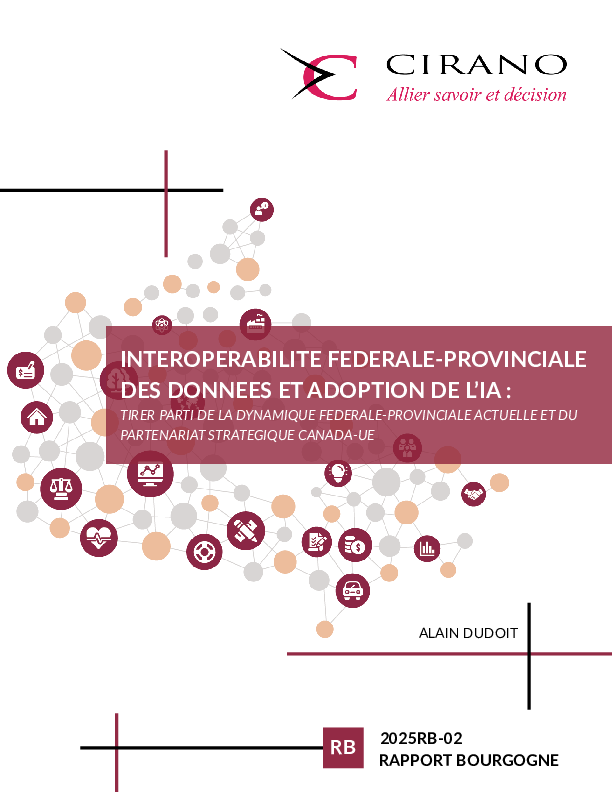© 2025 CIRANO. All rights reserved.
Upcoming events
October 30, 2025
Research and Data in Education: Enlightening Public Policy
Past events
Latest publications

Interopérabilité fédérale-provinciale des données et adoption de l’IA: Tirer parti de la dynamique fédérale-provinciale actuelle et du partenariat stratégique Canada-UE
- Backgrounder - Executive Summary - Update October 15th 2025 Canada is at a critical juncture where major economic challenges and geopolitical tensions and the required transformation of public services require a new way of managing and operating federal-provincial-territorial (FPT) relationships. At the heart of this transformation is the imperative to establish public sector data interoperability. This approach not only enables more efficient service delivery and the adoption of AI but also contributes to national productivity and digital sovereignty. At the centre of Canadian public sector governance and operations is the citizen, who is also the taxpayer (individual or business), consumer and end user of services provided by various levels of government: federal, provincial, territorial, and municipal. Citizens are entitled to continuous, efficient, safe, and reliable public services, regardless of jurisdiction. Meeting this expectation is a shared responsibility that no level of government can assume alone. The response requires a collaborative, whole-of-governments approach based on modern tools and coordinated strategies. Despite efforts, Canada’s intergovernmental relations remain hampered by fragmented and often outdated systems and a lack of cohesion in governance structures, which together prevent the scalable and adaptable use of data across jurisdictions. In response to these structural challenges and an increasingly unstable international environment, the current federal government has identified a set of strategic priorities that are inherently dependent on high-quality, integrated data systems: adapting to climate change, preparing for and managing crises, improving domestic trade; addressing housing and affordability; protecting our sovereignty; modernizing the public service; and accelerating AI-enabled innovation. This report highlights that barriers to interoperability are primarily political and institutional rather than technical. Drawing on international models such as the European Union’s Interoperable Europe Act and lessons learned from policy frameworks put in place by the United Kingdom, the G7 and California, the report proposes a Canadian path rooted in federated governance, modular agreements and data architectures based on trust, respect for jurisdictional responsibilities and individual rights. The report recommends two urgent measures: concluding an FPT agreement on data interoperability and creating a permanent FPT board on AI and interoperability. These initiatives are not mere technical adjustments: they are strategic and fundamental to any nation-building project. They respond to the Prime Minister’s call to identify projects with lasting benefits. The proposed FPT interoperability framework agreement aligns directly with the national interest designation criteria set out in Part 2 of Bill C-5, the Building Canada Act. It strengthens Canada’s autonomy, resilience, and security by supporting the sharing of cyber-resilient infrastructure and the coordination of emergency response capabilities. It also offers clear economic and institutional benefits by improving service delivery, facilitating labour mobility, and fostering conditions conducive to productivity growth through AI. This is not a marginal reform, but a fundamental change: a transformation of how governments collaborate, guided by the principles of transparency, subsidiarity, and shared objectives.
[ - ]












